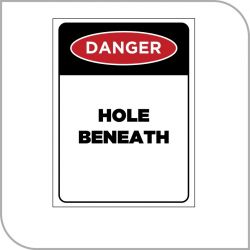Falls are a major cause of death and serious injury in Australian workplaces. Fall hazards can occur when carrying out common tasks in the construction of a typical one or two storey house.
Risk control measures
You must make stairwells, atriums and voids safe immediately after their construction to prevent workers or visitors to the site falling through whilst in these areas.
Covering the void may eliminate the risk of falling, provided the void cover:
- is made of material strong enough to withstand the likely impact of any person falling onto it
- can bear the weight of any static loads expected in the area of the void
- is fixed in place to prevent accidental dislodgement or removal
- has appropriate signage to indicate there is a void underneath.

Image source: Managing the risk of falls in the workplace ‑ Code of Practice
Where the building has a concrete floor, consider using cast-in safety mesh during the concrete pour to cover the voids. If safety mesh is used, the mesh must be strong enough to withstand the likely impact of any person falling onto it. You can cut out the safety mesh once the building is complete.

Image source: Managing the risk of falls in the workplace ‑ Code of Practice
If covering the void is not practical, you must use barriers such as perimeter guardrails or fall protection devices like scaffolding or safety nets to minimise the risk of falls.

Image source: Managing the risk of falls in housing construction - Code of Practice
Where a person working from a stepladder or a working platform, such as a trestle scaffold or similar, may fall over guard railing and through the opening, the opening must be covered with temporary flooring, timber sheeting, an industrial safety net or similar.
The Work Health and Safety Regulations 2012 (SA) classify a number of activities as ‘high risk construction work’ for which a Safe Work Method Statement (SWMS) must be prepared before the work starts. High risk construction work includes work that involves a risk of a person falling more than 3 metres.
Void scaffolds
Scaffolds are a temporary structure erected to support access or working platforms. Construction work commonly use scaffolds so workers have a safe, stable work platform when work can’t be done at ground level or on a finished floor.
Void scaffolds consist of a working platform supported on horizontal members that are in turn supported directly by the surrounding permanent structure and typically are used to fill a void, such as where a staircase is to be built or where a lift shaft is located.
A complete scaffold is classified as a structure and the individual components of a scaffold, for example tubes, couplers or frames are classified as items of plant.
Legal duties
Employers have a primary duty to ensure, so far as is reasonably practicable, that workers and other persons are not exposed to health and safety risks arising from the business or undertaking.
There are specific duties for businesses that install, construct or commission structures that are to be used, or could reasonably be expected to be used, as, or at, a workplace.
Businesses must ensure, so far as is reasonably practicable, that the way in which the structure is installed, constructed or commissioned ensures that the structure is without risks to the health and safety of people who:
- install or construct the structure at a workplace
- use the structure at a workplace for a purpose for which it was installed, constructed or commissioned
- are at or in the vicinity of a workplace and whose health or safety may be affected.
A business must have regard to:
- the information provided by the designer, manufacturer, importer or supplier of the structure under the Work Health and Safety Act 2012 (SA) and Work Health and Safety Regulations 2012 (SA); or
- the instructions provided by a competent person to the extent that those instructions relate to health and safety.
When purchasing scaffold equipment and/or components, the use of Standards from another country may not result in conformance with AS/NZS 1576: Scaffolding (Parts 1 - 4). Design, performance and/or test criteria may be of a lesser level in other Standards. It is imperative to ensure that a Standard from another country is equivalent to AS/NZS 1576: Scaffolding (Parts 1 - 4).
Further information
Managing risk of falls video series
Managing the risk of falls in the workplace ‑ Code of Practice
Managing the risk of falls in housing construction - Code of Practice
AS/NZS 1576: Scaffolding (Parts 1 - 4) – Approved Code of Practice
Scaffolding – Safe Work Australia
Falls through voids video – SafeWork NSW
How to prevent falls on a construction site using void covers video – SafeWork NSW
How to prevent falls on a construction site using temporary stairs video – SafeWork NSW


